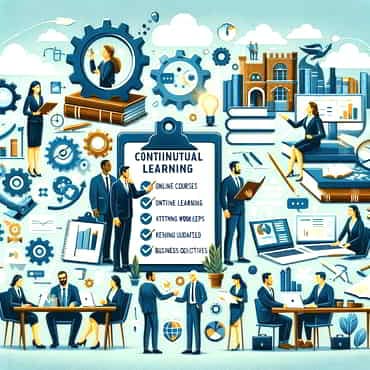Business And Personal Development Go Together: Strive For Your Aspirations

Estimated reading time: 8 Min
Business and personal development can go together. Make the most of development opportunities wherever they arise. Strive for your aspirations.
In the world today, where aspirations soar high, the words of the Greek poet and soldier Archilochus, from around 650 BC, still delivers a profound message: “We don’t rise to the level of our expectations; we fall to the level of our training.”
This observation is especially relevant in the realms of business development and personal growth.
Many start out to build their own enterprises, and often find themselves in the challenging gap between where they aspire to be and where they actually are.
This article explores the quote and its implications. especially for those at the early stages of developing a business.
It aims to inspire and guide readers, encouraging them to reach beyond external limitations, towards the heights of their beliefs in their own potential.
Business And Personal Development Compliment Each Other
At first glance, Archilochus’s words might seem disheartening, suggesting a cap on our achievements dictated by our training.
However, a deeper look reveals a more empowering message.
In the world of business and personal development, this concept underscores the importance of our own aspirations combined with training and preparation.
Training, in this context, is more than just about aquiring skills; it’s mainly about developing a mindset that prepares us for the challenges and opportunities of the business world.
It’s the foundation upon which aspirations can be built and realised.
While our own expectations paint a picture of our desired future, training can equip us with the tools to construct that future.
In business development, especially for new entrepreneurs, the gap between expectations and reality can often be wide.
Many enter the field with high hopes and grand visions but soon realise that the path to success is fraught with unexpected challenges.
This is where the significance of training becomes more obvious.
Effective training, whether it’s in strategic planning, market analysis, or financial management for example, provides the grounding needed to navigate these challenges effectively.
It’s often the difference between being swept away by the tides of uncertainty and steering confidently through them.
That difference can only be bridged by what we learn!
Learning requires that we implement the
Thus, understanding Archilochus’s statement is the first step in bridging the gap between our ambitions and our abilities.
It’s a call to action, urging us to invest time in our training, learning and development, while ensuring it aligns with and supports our goals as well as keeping any personal goals in sight.
Alignment is essential; without it, even the most ambitious expectations may remain unfulfilled, anchored by the limits of our preparation.
In the following sections, we’ll explore how this concept plays out in real-life scenarios, the psychological underpinnings of why we often settle for less, and, importantly, practical strategies to improve our training, align it with our goals, and reach for our true potential.
The Power of Effective Training

A compelling example of the impact of targeted training can be seen in the story of a school friend of mine from South Africa, who excelled in javelin throwing.
He was a frustrated competitor at school.
Although he was by far the best javelin thrower for his age locally, competing against all-comers of any age at the school when just 14 years old, he was never happy with his performance.
He thought he could do better.
Standing tall and naturally athletic, he was lucky enough to catch the attention of a talent scout at school and was trained for national competition in England.
Remarkably, with focused and specialised training, he managed to increase his javelin throwing distance by a staggering 50% within a few months.
This transformation highlights a vital lesson for business owners: just as athletes hone their skills to achieve remarkable feats, business owners can also refine their business skills to reach new heights.
In the business world, effective training can be transformative.
It’s not just about learning the basics; it’s about enthusiastically diving deep into the nuances of your industry, understanding your market, and mastering the art of decision-making.
For an entrepreneur, effective training could mean attending workshops on the latest market trends, seeking mentorship from seasoned business leaders, or enrolling in courses that enhance strategic thinking skills.
This approach to training does more than just prepare you for the expected; it arms you with the ability to anticipate, adapt to, and capitalize on the unexpected.
But I emphasise the need for learning: this means implementing (taking action) with what you learn, searching for and accepting useful feedback and continuously developing your skills.
Overcoming the Tendency to Settle
Why do many of us fall to the level of our training instead of rising to our potential?
The answer often lies in our mindset.
Comfort zones are seductive; they offer a safe haven where the fear of failure is minimised.
Stepping beyond them requires not only courage but also the conviction that our efforts will pay off.
This psychological barrier, where the fear of the unknown overrides the desire for growth, is what often keeps individuals and businesses from reaching their full potential.
To overcome this, it’s essential to develop a mindset for growth.
Although Dr Carol Dweck’s writings have made the term “growth mindset” popular today, the basic ideas have been around since at least the 196os and probably much earlier.
It means embracing failure as a part of the journey towards success and viewing challenges, not as insurmountable obstacles, but as opportunities for development and learning.
In the business world, this translates to a willingness to experiment with new strategies, explore new markets, and take calculated risks.
Additionally, entrepreneurs must be vigilant against complacency.
A degree of success can breed a false sense of security, leading to a relaxation in efforts to improve and innovate.
It’s vital to continuously seek ways to enhance skills and knowledge, keeping abreast of industry changes and evolving consumer demands.
Lastly, building a support network can play a significant role in overcoming the tendency to settle.
Surrounding oneself with mentors, peers, and employees who challenge and inspire can create an environment conducive to growth and excellence.
Such a network not only provides valuable insights and feedback but also encourages accountability, pushing you to strive for higher standards.
For members of Wealthy Affiliate I’m certain there’s nothing new in these ideas.
In the next sections, we explore a few practical strategies that business owners and entrepreneurs can implement to enhance their training and align it more closely with their ambitions.
Strategies for Business Owners and Entrepreneurs
For business owners and entrepreneurs keen on transcending the limitations of their current training, adopting a strategic approach is key. Here are some actionable steps:

- Invest in Continuous Learning
The business landscape is constantly evolving. Keep abreast of industry trends, technological advancements, and market shifts through continuous learning. This could involve online courses, attending workshops, or even pursuing further formal education. - Seek Mentorship
Learning from those who have already navigated the path can be invaluable. Seek out mentors who can provide guidance, share experiences, and offer different perspectives on your business challenges. - Create a Culture of Learning in Your Team
If you have a team, encourage them to pursue learning opportunities. This not only improves their skills but also fosters an environment where growth and development are prioritized. - Set Specific Training Goals
Align your training with your business objectives. Obviously this means that you need to have clear business objectives first. Set specific, measurable goals for what you want to achieve through your training efforts, ensuring they directly contribute to the growth and success of your business. - Implement What You Learn
This is where many people fall down. Applying new knowledge and skills is just as important as acquiring them. Experiment with new strategies and techniques in your business to see what works best and refine your approach accordingly. - Networking and Collaboration
Engage with other professionals and entrepreneurs. Networking can provide new ideas, opportunities for collaboration, and insights into different approaches to business challenges.
Continuous Improvement and Growth
The journey towards reaching one’s potential in business is ongoing.
It requires a commitment to continuous improvement and an openness to change.
Here are some ways to ensure you’re consistently growing:

- Regularly Review and Adapt Your Training Plan
As your business evolves, so should your training. Regularly review your learning and development plans to ensure they remain relevant and effective. Not sure how? Discuss possibilities with a mentor. - Embrace Feedback
Constructive feedback, whether from customers, mentors, or team members, can provide critical insights into areas needing improvement. Embrace it and use it as a tool for growth. - Stay Curious
Maintain a sense of curiosity about your industry and business in general. Curiosity leads to exploration and discovery, which are essential for innovation and staying ahead of the curve. - Balance Theory with Practice
While acquiring knowledge is important, real growth often comes from applying what you’ve learned in practical, real-world scenarios. Balance your theoretical learning with hands-on experience. - Reflect on Your Progress
Regular reflection on your achievements and areas for improvement can provide a clearer perspective on your growth trajectory. It also helps in setting more targeted goals for the future.
Encouraging Case Studies and Examples
To further illustrate the power of training and continuous improvement, let’s look at some inspiring case studies:
- Case Study 1:
A small tech startup, initially struggling with product development, invested heavily in upskilling its team in the latest programming languages and agile methodologies. This led to a breakthrough in product innovation, resulting in a significant market share gain within a year. - Case Study 2:
An entrepreneur in the retail sector, facing stagnant growth, decided to undergo training in digital marketing and e-commerce. Applying these new skills transformed her brick-and-mortar business into a thriving online store, expanding her customer base globally. - Case Study 3:
A local coffee shop owner, noticing a decline in customer engagement, trained his staff in customer service excellence and introduced a loyalty program. This move not only increased repeat business but also enhanced the shop’s reputation in the community.
These examples underscore the impact of targeted training and adaptation in various business contexts.
They demonstrate how investing in training and embracing continuous learning can lead to significant improvements in business performance and growth.
Summary
The objective to not just meet but exceed our potential in business and personal development is intrinsically linked to our aspirations, the level of our training and our commitment to continuous improvement.
As Archilochus wisely stated, our achievements often align more closely with our training than our expectations.
To bridge this gap, it’s essential to invest in comprehensive training that aligns with our goals, seek mentorship, create a culture of learning, and continuously adapt and grow.
Remember, the potential to achieve greatness in business and personal endeavours lies within the scope of our training and our willingness to push beyond comfort zones.
By adopting a proactive approach to learning and development, keeping our own ambitions in mind, embracing challenges as opportunities, and fostering a mindset of perpetual growth, entrepreneurs and business owners can transcend their current limitations and reach new heights of success and fulfilment.
Let this be a call to action: to invest in yourself, in your skills, and in your future.
It’s not so much about falling to the level of our training; it’s more about rising above it, reaching for the stars, and achieving what we once thought was beyond our reach.
If you have anything to add, please do so in the comments and ask any questions via the contact form.
🙂
Richard


![Are Wealthy Affiliate Hubs Revolutionising Website & Content Development In [year]? A futuristic and sleek digital workspace designed for website management and content creation - Wealthy Affiliate Hubs](https://ml0yvzumdtic.i.optimole.com/cb:k6B_.1fa14/w:740/h:370/q:mauto/https://solobusinessmind.com/wp-content/uploads/2024/12/A-futuristic-and-sleek-digital-workspace-designed-for-website-management-and-content-creation-Wealthy-Affiliate-Hubs740x370-O.jpg)



